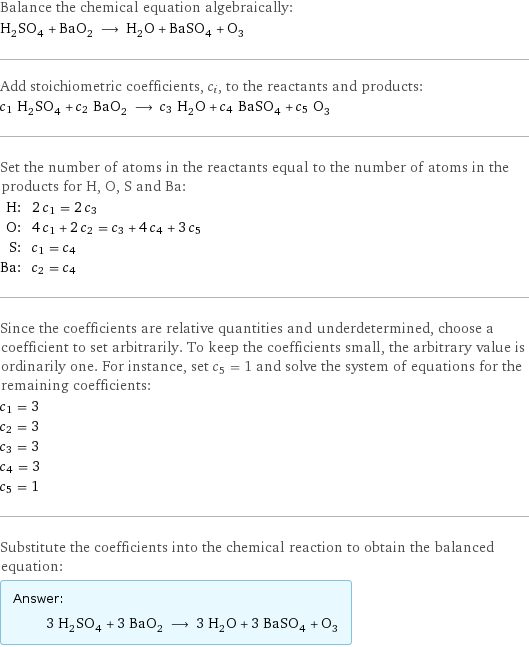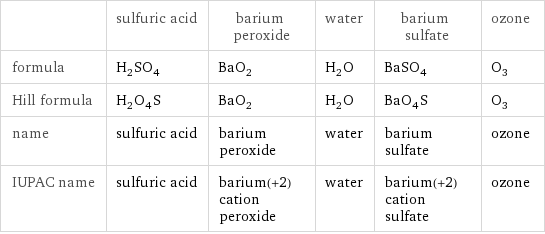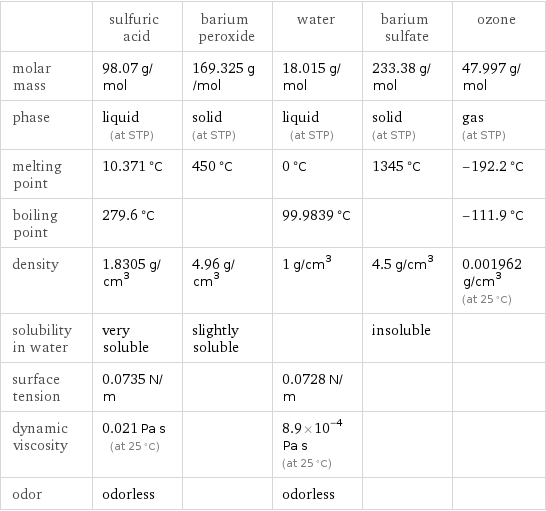Input interpretation

H_2SO_4 sulfuric acid + BaO_2 barium peroxide ⟶ H_2O water + BaSO_4 barium sulfate + O_3 ozone
Balanced equation

Balance the chemical equation algebraically: H_2SO_4 + BaO_2 ⟶ H_2O + BaSO_4 + O_3 Add stoichiometric coefficients, c_i, to the reactants and products: c_1 H_2SO_4 + c_2 BaO_2 ⟶ c_3 H_2O + c_4 BaSO_4 + c_5 O_3 Set the number of atoms in the reactants equal to the number of atoms in the products for H, O, S and Ba: H: | 2 c_1 = 2 c_3 O: | 4 c_1 + 2 c_2 = c_3 + 4 c_4 + 3 c_5 S: | c_1 = c_4 Ba: | c_2 = c_4 Since the coefficients are relative quantities and underdetermined, choose a coefficient to set arbitrarily. To keep the coefficients small, the arbitrary value is ordinarily one. For instance, set c_5 = 1 and solve the system of equations for the remaining coefficients: c_1 = 3 c_2 = 3 c_3 = 3 c_4 = 3 c_5 = 1 Substitute the coefficients into the chemical reaction to obtain the balanced equation: Answer: | | 3 H_2SO_4 + 3 BaO_2 ⟶ 3 H_2O + 3 BaSO_4 + O_3
Structures

+ ⟶ + +
Names

sulfuric acid + barium peroxide ⟶ water + barium sulfate + ozone
Equilibrium constant
![Construct the equilibrium constant, K, expression for: H_2SO_4 + BaO_2 ⟶ H_2O + BaSO_4 + O_3 Plan: • Balance the chemical equation. • Determine the stoichiometric numbers. • Assemble the activity expression for each chemical species. • Use the activity expressions to build the equilibrium constant expression. Write the balanced chemical equation: 3 H_2SO_4 + 3 BaO_2 ⟶ 3 H_2O + 3 BaSO_4 + O_3 Assign stoichiometric numbers, ν_i, using the stoichiometric coefficients, c_i, from the balanced chemical equation in the following manner: ν_i = -c_i for reactants and ν_i = c_i for products: chemical species | c_i | ν_i H_2SO_4 | 3 | -3 BaO_2 | 3 | -3 H_2O | 3 | 3 BaSO_4 | 3 | 3 O_3 | 1 | 1 Assemble the activity expressions accounting for the state of matter and ν_i: chemical species | c_i | ν_i | activity expression H_2SO_4 | 3 | -3 | ([H2SO4])^(-3) BaO_2 | 3 | -3 | ([BaO2])^(-3) H_2O | 3 | 3 | ([H2O])^3 BaSO_4 | 3 | 3 | ([BaSO4])^3 O_3 | 1 | 1 | [O3] The equilibrium constant symbol in the concentration basis is: K_c Mulitply the activity expressions to arrive at the K_c expression: Answer: | | K_c = ([H2SO4])^(-3) ([BaO2])^(-3) ([H2O])^3 ([BaSO4])^3 [O3] = (([H2O])^3 ([BaSO4])^3 [O3])/(([H2SO4])^3 ([BaO2])^3)](../image_source/10b890557eedeb614711b3694a8e9736.png)
Construct the equilibrium constant, K, expression for: H_2SO_4 + BaO_2 ⟶ H_2O + BaSO_4 + O_3 Plan: • Balance the chemical equation. • Determine the stoichiometric numbers. • Assemble the activity expression for each chemical species. • Use the activity expressions to build the equilibrium constant expression. Write the balanced chemical equation: 3 H_2SO_4 + 3 BaO_2 ⟶ 3 H_2O + 3 BaSO_4 + O_3 Assign stoichiometric numbers, ν_i, using the stoichiometric coefficients, c_i, from the balanced chemical equation in the following manner: ν_i = -c_i for reactants and ν_i = c_i for products: chemical species | c_i | ν_i H_2SO_4 | 3 | -3 BaO_2 | 3 | -3 H_2O | 3 | 3 BaSO_4 | 3 | 3 O_3 | 1 | 1 Assemble the activity expressions accounting for the state of matter and ν_i: chemical species | c_i | ν_i | activity expression H_2SO_4 | 3 | -3 | ([H2SO4])^(-3) BaO_2 | 3 | -3 | ([BaO2])^(-3) H_2O | 3 | 3 | ([H2O])^3 BaSO_4 | 3 | 3 | ([BaSO4])^3 O_3 | 1 | 1 | [O3] The equilibrium constant symbol in the concentration basis is: K_c Mulitply the activity expressions to arrive at the K_c expression: Answer: | | K_c = ([H2SO4])^(-3) ([BaO2])^(-3) ([H2O])^3 ([BaSO4])^3 [O3] = (([H2O])^3 ([BaSO4])^3 [O3])/(([H2SO4])^3 ([BaO2])^3)
Rate of reaction
![Construct the rate of reaction expression for: H_2SO_4 + BaO_2 ⟶ H_2O + BaSO_4 + O_3 Plan: • Balance the chemical equation. • Determine the stoichiometric numbers. • Assemble the rate term for each chemical species. • Write the rate of reaction expression. Write the balanced chemical equation: 3 H_2SO_4 + 3 BaO_2 ⟶ 3 H_2O + 3 BaSO_4 + O_3 Assign stoichiometric numbers, ν_i, using the stoichiometric coefficients, c_i, from the balanced chemical equation in the following manner: ν_i = -c_i for reactants and ν_i = c_i for products: chemical species | c_i | ν_i H_2SO_4 | 3 | -3 BaO_2 | 3 | -3 H_2O | 3 | 3 BaSO_4 | 3 | 3 O_3 | 1 | 1 The rate term for each chemical species, B_i, is 1/ν_i(Δ[B_i])/(Δt) where [B_i] is the amount concentration and t is time: chemical species | c_i | ν_i | rate term H_2SO_4 | 3 | -3 | -1/3 (Δ[H2SO4])/(Δt) BaO_2 | 3 | -3 | -1/3 (Δ[BaO2])/(Δt) H_2O | 3 | 3 | 1/3 (Δ[H2O])/(Δt) BaSO_4 | 3 | 3 | 1/3 (Δ[BaSO4])/(Δt) O_3 | 1 | 1 | (Δ[O3])/(Δt) (for infinitesimal rate of change, replace Δ with d) Set the rate terms equal to each other to arrive at the rate expression: Answer: | | rate = -1/3 (Δ[H2SO4])/(Δt) = -1/3 (Δ[BaO2])/(Δt) = 1/3 (Δ[H2O])/(Δt) = 1/3 (Δ[BaSO4])/(Δt) = (Δ[O3])/(Δt) (assuming constant volume and no accumulation of intermediates or side products)](../image_source/f542d1b07d58bee0ee14a646026666e7.png)
Construct the rate of reaction expression for: H_2SO_4 + BaO_2 ⟶ H_2O + BaSO_4 + O_3 Plan: • Balance the chemical equation. • Determine the stoichiometric numbers. • Assemble the rate term for each chemical species. • Write the rate of reaction expression. Write the balanced chemical equation: 3 H_2SO_4 + 3 BaO_2 ⟶ 3 H_2O + 3 BaSO_4 + O_3 Assign stoichiometric numbers, ν_i, using the stoichiometric coefficients, c_i, from the balanced chemical equation in the following manner: ν_i = -c_i for reactants and ν_i = c_i for products: chemical species | c_i | ν_i H_2SO_4 | 3 | -3 BaO_2 | 3 | -3 H_2O | 3 | 3 BaSO_4 | 3 | 3 O_3 | 1 | 1 The rate term for each chemical species, B_i, is 1/ν_i(Δ[B_i])/(Δt) where [B_i] is the amount concentration and t is time: chemical species | c_i | ν_i | rate term H_2SO_4 | 3 | -3 | -1/3 (Δ[H2SO4])/(Δt) BaO_2 | 3 | -3 | -1/3 (Δ[BaO2])/(Δt) H_2O | 3 | 3 | 1/3 (Δ[H2O])/(Δt) BaSO_4 | 3 | 3 | 1/3 (Δ[BaSO4])/(Δt) O_3 | 1 | 1 | (Δ[O3])/(Δt) (for infinitesimal rate of change, replace Δ with d) Set the rate terms equal to each other to arrive at the rate expression: Answer: | | rate = -1/3 (Δ[H2SO4])/(Δt) = -1/3 (Δ[BaO2])/(Δt) = 1/3 (Δ[H2O])/(Δt) = 1/3 (Δ[BaSO4])/(Δt) = (Δ[O3])/(Δt) (assuming constant volume and no accumulation of intermediates or side products)
Chemical names and formulas

| sulfuric acid | barium peroxide | water | barium sulfate | ozone formula | H_2SO_4 | BaO_2 | H_2O | BaSO_4 | O_3 Hill formula | H_2O_4S | BaO_2 | H_2O | BaO_4S | O_3 name | sulfuric acid | barium peroxide | water | barium sulfate | ozone IUPAC name | sulfuric acid | barium(+2) cation peroxide | water | barium(+2) cation sulfate | ozone
Substance properties

| sulfuric acid | barium peroxide | water | barium sulfate | ozone molar mass | 98.07 g/mol | 169.325 g/mol | 18.015 g/mol | 233.38 g/mol | 47.997 g/mol phase | liquid (at STP) | solid (at STP) | liquid (at STP) | solid (at STP) | gas (at STP) melting point | 10.371 °C | 450 °C | 0 °C | 1345 °C | -192.2 °C boiling point | 279.6 °C | | 99.9839 °C | | -111.9 °C density | 1.8305 g/cm^3 | 4.96 g/cm^3 | 1 g/cm^3 | 4.5 g/cm^3 | 0.001962 g/cm^3 (at 25 °C) solubility in water | very soluble | slightly soluble | | insoluble | surface tension | 0.0735 N/m | | 0.0728 N/m | | dynamic viscosity | 0.021 Pa s (at 25 °C) | | 8.9×10^-4 Pa s (at 25 °C) | | odor | odorless | | odorless | |
Units
